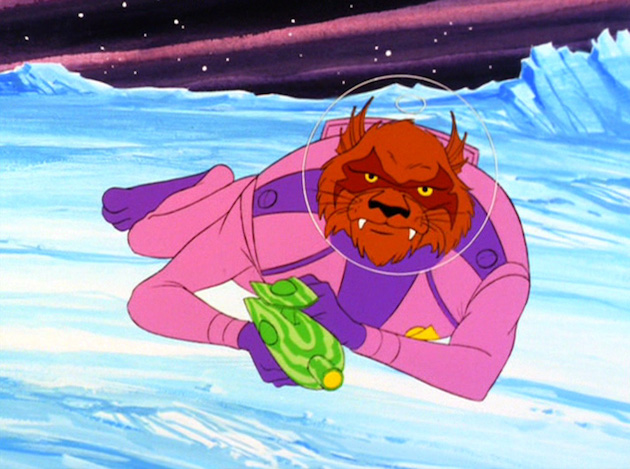“The Slaver Weapon”
Written by Larry Niven
Directed by Hal Sutherland
Animated Season 1, Episode 14
Production episode 22011
Original air date: December 15, 1973
Stardate: 4187.3
Captain’s log. Spock, Sulu, and Uhura are on the shuttlecraft Copernicus, delivering a Slaver stasis box that was recently discovered by Kzinti archaeologists to Starbase 25. Whatever is inside the stasis box has been perfectly preserved for as long as it’s been in existence—and the Slavers conquered the entire galaxy billions of years earlier, and when they were wiped out, life had to evolve in the galaxy from scratch. The stasis boxes that have been found are the only source of information they have about that long-ago time.
The stasis box starts to glow, which indicates that there’s another stasis box in the nearby star system of Beta Lyrae. Spock orders Sulu to change course to the system, since the only thing that detects a stasis box is another stasis box.
The Copernicus lands on an icy planet. Just as the landing party detects the location of the stasis box, they are ambushed by a party of Kzinti and taken prisoner.
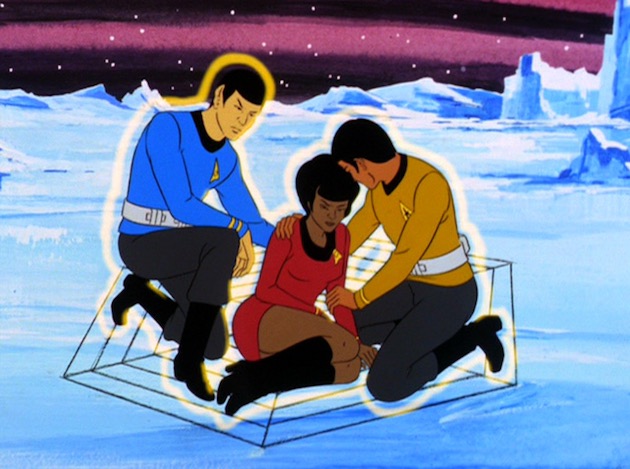
The Kzinti are only willing to deal directly with Sulu, as Spock is a vegetarian, for whom the Kzinti have no respect, and Uhura is a woman. Kzinti females are little more than dumb animals, and Spock instructs Uhura to play to that notion, so her being unnoticed might be turned to their advantage.
They’re interrogated by Chuft Captain, who commands this stolen police vessel, Traitor’s Claw. They’re privateers—or, at least, they claim to be. In truth, they’re covert operatives for the Kzinti government, trying to find weapons they can use to fight another war against the Federation. The stasis box on this world was empty, but they used it as a lure to draw the Copernicus there so they could get their hands on the box in their possession.
Chuft Captain opens the box, which contains a picture of a Slaver, a piece of raw meat, and a weapon of some sort. The meat turns out to be poisonous, but the weapon has several settings that change the shape of the object. At least one setting is a telescope, another is a laser, and another is a rocket that sends Chuft Captain careening about the landscape. Uhura is able to escape the web that has the landing party trapped, but the Kzinti gun her down.
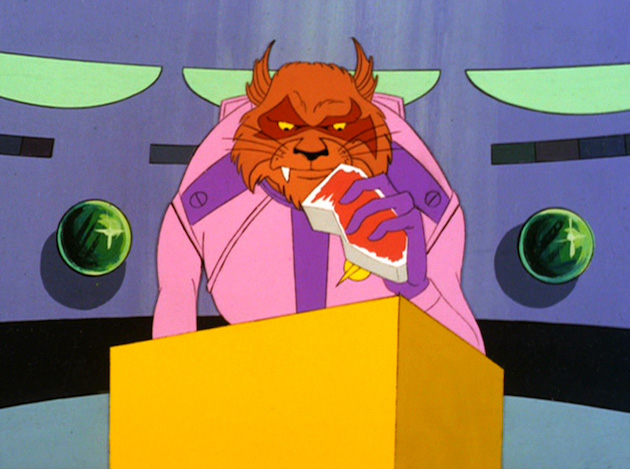
Another setting is an energy absorber, though somehow it doesn’t affect their life-support belts. It does deactivate the web they’re trapped in, however, and the trio make a run for it, going off in all directions. Spock attacks Chuft Captain and takes the weapon. But Uhura is, once again, gunned down.
Now Chuft Captain has Uhura as a hostage, but Spock has the weapon. Spock also dishonored Chuft Captain—he’s a plant eater, and he attacked Chuft Captain and didn’t kill him. That’s a shame that will keep him from calling for reinforcements.
Chuft Captain offers Spock combat—basically a rematch—but they refuse. Sulu and Spock continue to test the weapon, and they find a setting that causes such severe damage as to affect the weather. The subsequent windstorm knocks them unconscious and allows them to be captured again.
The Kzinti finds another setting which allows an AI within the weapon to communicate with them. The computer voice asks for several codewords, which of course, the Kzinti don’t know. When Chuft Captain asks for the high-energy beam setting that Sulu used earlier, the computer provides a setting which changes to a configuration that is not the same as what Sulu found earlier. Spock deduces that the weapon believes it has fallen into enemy hands and has gone to the self-destruct setting. Sure enough, when Chuft Captain tests it, it blows up, killing all the Kzinti. Inside the police web, the landing party is protected.
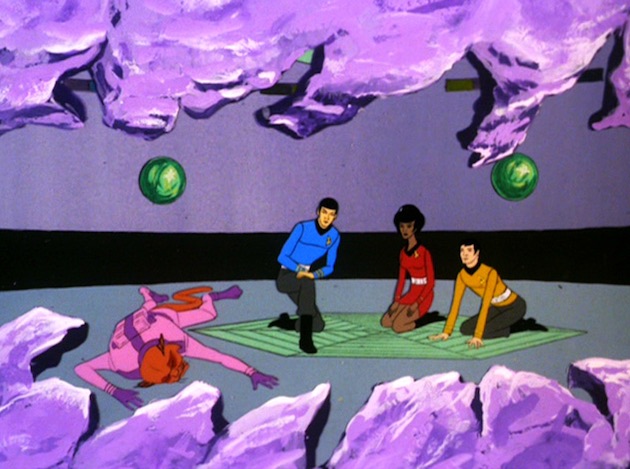
They re-board the Copernicus and head back on course, since they still have two (now empty) stasis boxes and a picture of a Slaver to deliver to Starbase 25.
Can’t we just reverse the polarity? One stasis box that was found in the past had a flying belt that was the basis of artificial gravity technology. Another had a bomb in it that went off as soon as the box was opened—because of that, Starfleet automatically gets jurisdiction of all stasis boxes that are found, and they can only be opened by specialists.
Fascinating. Spock uses the Kzinti cultural prejudices against them, in particular making sure to attack Chuft Captain and leave him alive to shame him, thus keeping him from calling in reinforcements.
Ahead warp one, aye. Sulu speaks for the landing party to the Kzinti, as they won’t talk to an herbivore or a woman. He figures out that the crew of Traitor’s Claw are truly government operatives posing as privateers who can be disavowed. He also theorizes that the weapon is one of spycraft rather than that of a soldier, and his logic actually impresses Spock.
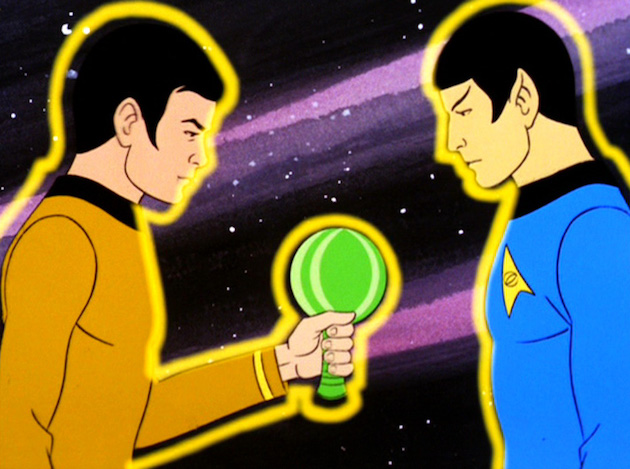
Hailing frequencies open. Uhura is not thrilled at the notion of having to pretend to be stupid. Then again, she also tries to escape twice and both times get shot and recaptured…
Channel open.
“They think very little of you.”
“Wrong. They don’t think much of you.”
–Chuft Captain’s reaction to Spock refusing a rematch, and Uhura setting him straight.
Welcome aboard. James Doohan does the voices of some of the various Kzinti—he’s definitely Chuft Captain and his second, and he might be the telepath. Majel Barrett is the voice of the slaver weapon’s computer, and George Takei and Nichelle Nichols are the voices of Sulu and Uhura.
Trivial matters: Larry Niven adapted his short story “The Soft Weapon” into this episode, which is part of his “Known Space” oeuvre, including the popular Man-Kzin Wars anthology series. D.C. Fontana and Gene Roddenberry specifically recruited him to write an episode for the animated series, encouraged by them to adapt one of his “Known Space” short stories.
This is the first Star Trek screen story since the introduction of the character that does not feature Kirk. The next one will be “Encounter at Farpoint,” the premiere of TNG in 1987.
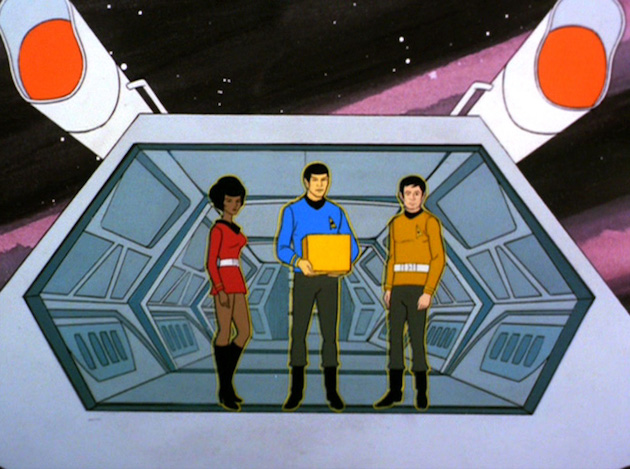
Vulcans being vegetarians was established in “All Our Yesterdays,” thus making Spock an amusing analogue for Nessus, the character in the story who is also a pacifist and an herbivore, though Nessus is manic-depressive and insane.
Sulu’s affinity for weapons was established in “Shore Leave” when he geeked out over an old pistol.
This is the only appearance of the Kzinti in the Star Trek universe on screen, and they’re never mentioned again (though they were mentioned in “The Infinite Vulcan” and seen in “The Time Trap” prior to this), mostly to avoid copyright issues. The Kzinti do appear in the game Star Fleet Battles (that game’s odd partial license included the animated series, although the Kzinti in the game vary from the Kzinti of this episode in some aspects), and also appeared in a run of the Star Trek comic strip that was co-authored by Niven and Sharman DiVono in 1982. Niven did open the Kzinti to other authors in his Man-Kzin Wars anthologies, of which there have been fourteen as of this writing.
The main difference between how the Kzinti are described in Niven’s prose and how they’re portrayed visually here is the lack of stripes, as apparently stripes would be too expensive to animate, and so they are monochrome.
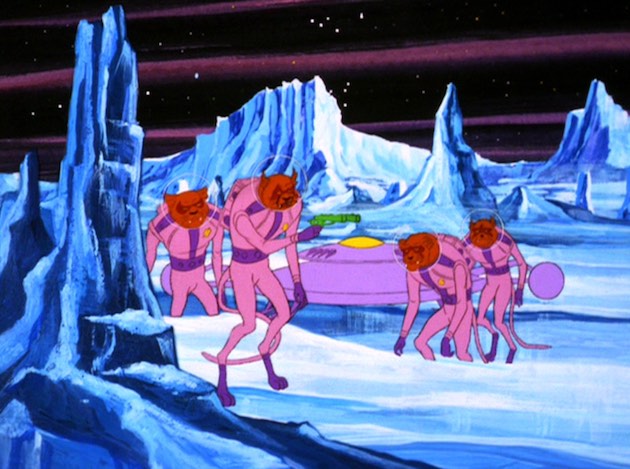
To boldly go. “He makes me taste yellow root munched between flat teeth!” I absolutely adore this episode, and consider it to be one of the finest Trek episodes extant. Part of that is because it keeps things simple, just the three people on the shuttlecraft—and those three are not Kirk, Spock, and McCoy. What’s more, Larry Niven does an excellent job of making use of what we already know about Spock (that he’s a pacifist and a vegetarian) and Sulu (he’s a weapons collector).
And in the Kzinti we have a fascinating alien culture with cultural mores that are a sensible extrapolation of a feline species. I particularly like the telepath who is revolted by the images he receives of eating plants in Sulu and Spock’s heads.
On top of that, we have the Slavers and the stasis boxes, both nifty science fictional concepts.
I could live without the sexism—one thing that is not a sensible extrapolation of a feline species is the notion of women as dumb animals, plus Uhura is basically useless in the episode—and in truth the telepath doesn’t actually serve much of a plot function. And there’s a bit too much of our heroes being captured, freed, and captured again.
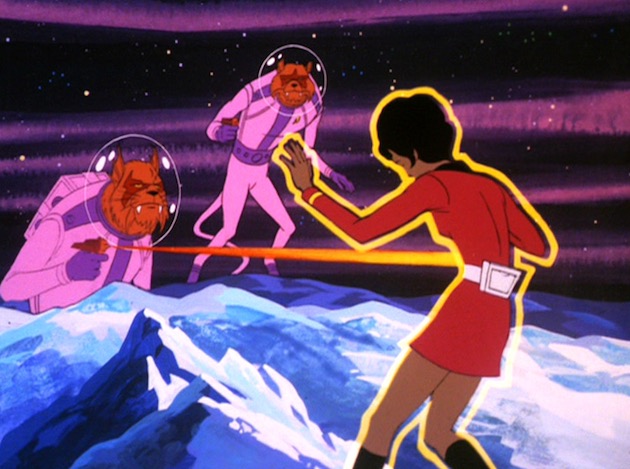
But I like the intelligent conversations among the landing party about history and archaeology and the doping out of the weapon. I like the way Spock tries to play the Kzinti, and only partially succeeds (for starters, Chuft Captain knows that Uhura is intelligent, and so Spock’s hope that they won’t notice her turns out to be a forlorn one). And I like the fact that this story actually works perfectly in the half-hour format. Too many of the animated episodes either have too little or too much story for the running time, but this one is just right.
Once again, Star Trek proves that hiring science fiction authors to write science fiction stories will give you quality work—viz., “The City on the Edge of Forever,” “Amok Time,” “The Doomsday Machine,” and this.
Warp factor rating: 9
Next week: “The Eye of the Beholder”
Keith R.A. DeCandido will be a guest at the first-ever HELIOsphere convention in Tarrytown, New York this weekend, alongside guests of honor David Gerrold, Jacqueline Carey, and Danielle Ackley-McPhail, among many others. Saturday will be the launch party for Baker Street Irregulars, the alternate Sherlock Holmes anthology that Keith has a story in; fellow contributors Gerrold, Austin Farmer, and Hildy Silverman, and co-editor Michael A. Ventrella will also be there. Keith’s full schedule can be found here.










